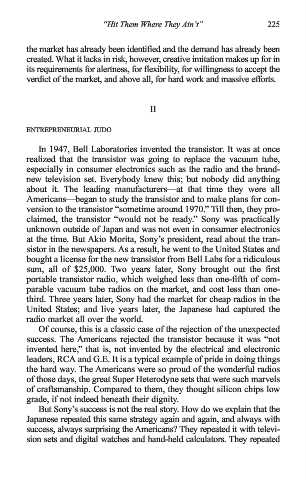Page 232 - ENTREPRENEURSHIP Innovation and entrepreneurship
P. 232
53231_Innovation and Entrepreneurship.qxd 11/8/2002 10:50 AM Page 225
“Hit Them Where They Ain’t” 225
the market has already been identified and the demand has already been
created. What it lacks in risk, however, creative imitation makes up for in
its requirements for alertness, for flexibility, for willingness to accept the
verdict of the market, and above all, for hard work and massive efforts.
II
ENTREPRENEURIAL JUDO
In 1947, Bell Laboratories invented the transistor. It was at once
realized that the transistor was going to replace the vacuum tube,
especially in consumer electronics such as the radio and the brand-
new television set. Everybody knew this; but nobody did anything
about it. The leading manufacturers—at that time they were all
Americans—began to study the transistor and to make plans for con-
version to the transistor “sometime around 1970.” Till then, they pro-
claimed, the transistor “would not be ready.” Sony was practically
unknown outside of Japan and was not even in consumer electronics
at the time. But Akio Morita, Sony’s president, read about the tran-
sistor in the newspapers. As a result, he went to the United States and
bought a license for the new transistor from Bell Labs for a ridiculous
sum, all of $25,000. Two years later, Sony brought out the first
portable transistor radio, which weighed less than one-fifth of com-
parable vacuum tube radios on the market, and cost less than one-
third. Three years later, Sony had the market for cheap radios in the
United States; and live years later, the Japanese had captured the
radio market all over the world.
Of course, this is a classic case of the rejection of the unexpected
success. The Americans rejected the transistor because it was “not
invented here,” that is, not invented by the electrical and electronic
leaders, RCA and G.E. It is a typical example of pride in doing things
the hard way. The Americans were so proud of the wonderful radios
of those days, the great Super Heterodyne sets that were such marvels
of craftsmanship. Compared to them, they thought silicon chips low
grade, if not indeed beneath their dignity.
But Sony’s success is not the real story. How do we explain that the
Japanese repeated this same strategy again and again, and always with
success, always surprising the Americans? They repeated it with televi-
sion sets and digital watches and hand-held calculators. They repeated

